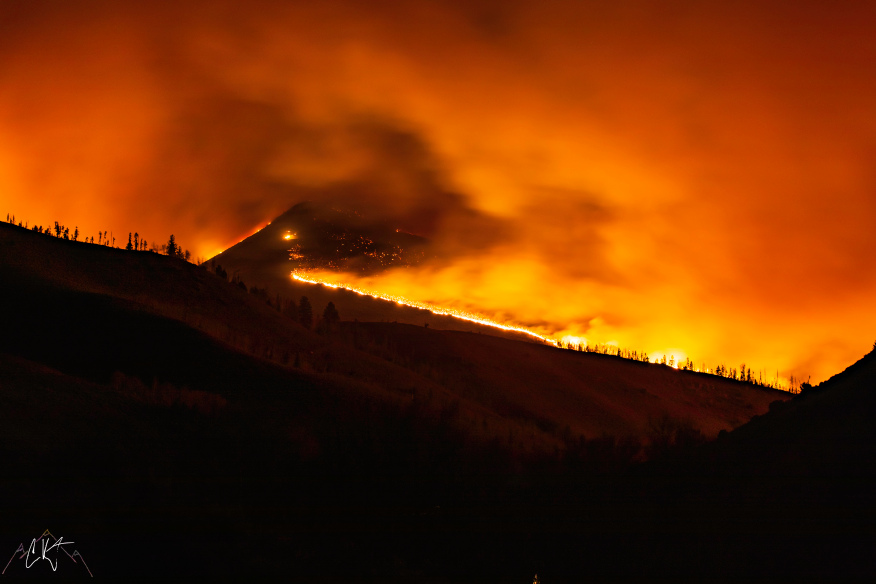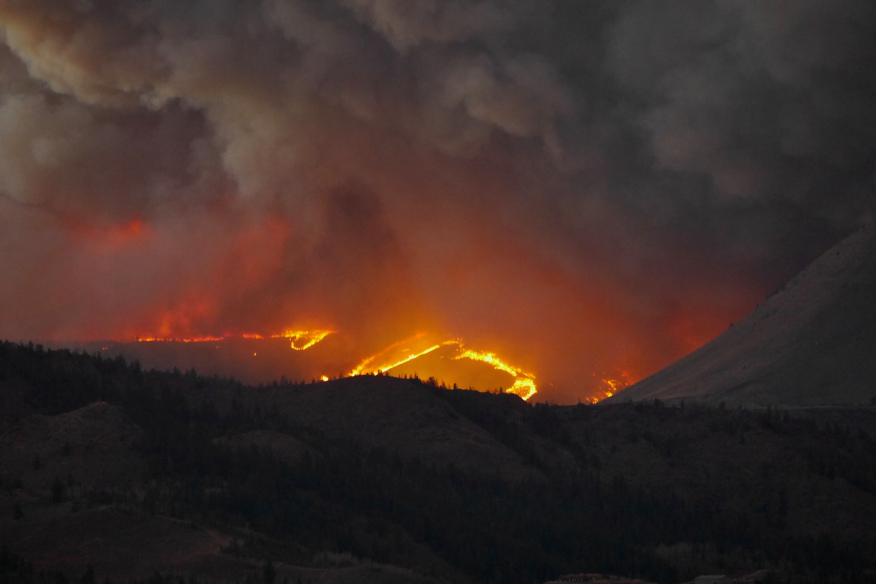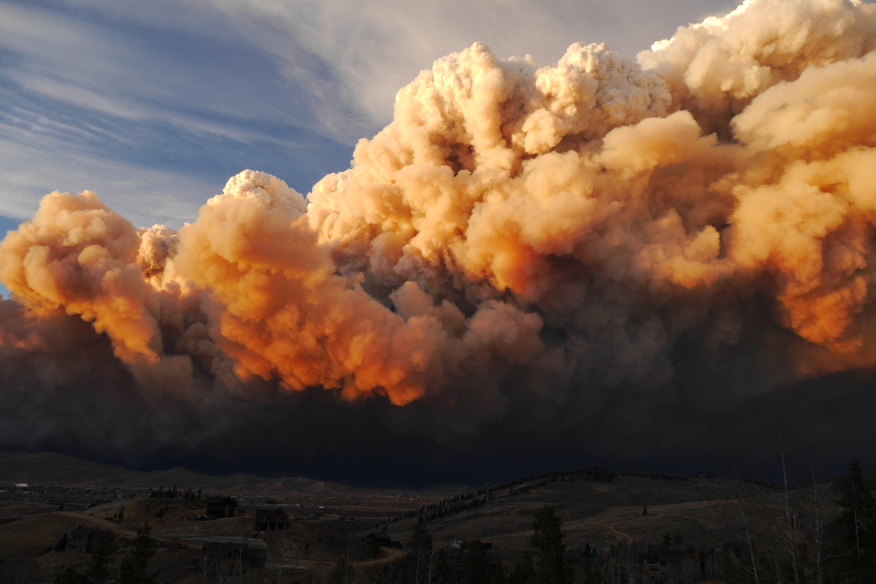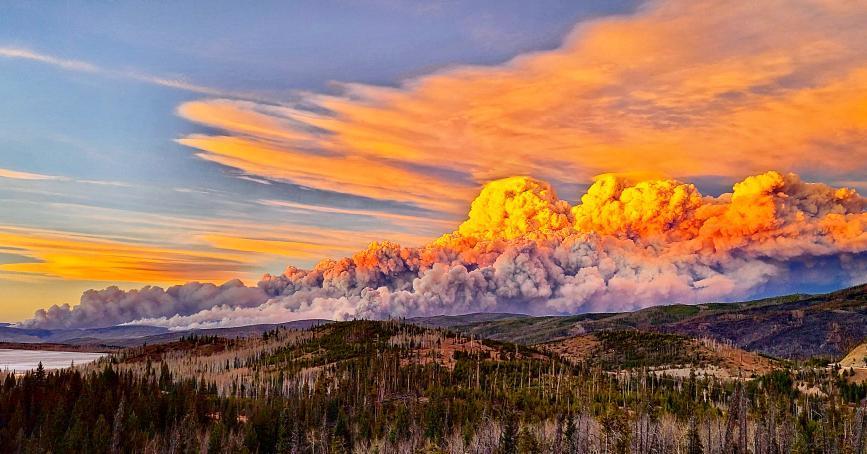DENVER (NewsNation Now) — At least 3,000 firefighters are fighting Colorado’s largest wildfire on record as another fire erupted, growing at a rate of 6,000 acres per hour overnight according to officials.
The East Troublesome Fire erupted Oct. 14 and has exploded to 125,602 acres by Thursday morning forcing more immediate evacuations, according to the incident report. The fire was 5% contained.
More than 700 square miles (1,813 square kilometers) of land has burned in Colorado at a cost of more than $215 million — with the numbers still rising, according to Larry Helmerick, fire information coordinator for the Rocky Mountain Area Coordination Center.
“It was a challenging day,” Grand County Sheriff Brett Schroetlin said early Thursday morning. “Daylight’s going to tell us a lot.”
Strong winds and dry fuel allowed the fire to grow at a rate of 6,000 acres per hour he said. Burning up grass, sage and lodgepole pine, the fire blackened land north of Hot Sulphur Springs and west of Rocky Mountain National Park.
Fire crews scrambled Thursday overnight to contain other fires to the south in Boulder County and to the west of Rocky Mountain National Park. All told, according to the Rocky Mountain Coordination Center, an interagency support organization, about 3,000 firefighters were battling roughly 441,600 acres of land charred by wildfires in north-central Colorado and southern Wyoming.
Citing the fire threat, the U.S. Forest Service on Wednesday closed about 995,200 acres of forest land in five counties near Colorado’s heavily populated Front Range — an area bigger than the state of Rhode Island.
“These temporary closures are necessary to protect the public and our firefighters, and we will keep them in place until conditions improve and we are confident that the risk of new fire starts has decreased,” Forest Supervisor Monte Williams said in a statement.
Colorado fire officials posted the video by tweet this week to drive home the unprecedented late-season fire danger crews face in trying to contain the Cameron Peak Fire, west of the cities of Fort Collins and Loveland. In the video, a group of firefighters brace themselves against a furious wind blowing dust and debris and fanning flames in a reddish-orange Martian landscape that is all too real for crews battling several dangerous wildfires in northern Colorado and southern Wyoming.
Firefighters confronted another red flag day Wednesday with sustained winds of up to 50 mph in trying to protect structures in a handful of hamlets threatened by the Cameron Peak fire.
Crews aren’t banking on early predictions of Front Range snow later this week and this weekend, though any precipitation is welcome, Kleist said. Fire meteorologists say the bulk of any snow may avoid the Cameron Peak blaze, he said.
Crews supported by water-dropping helicopters focused Wednesday on protecting homes and other structures in the hamlets of Glen Haven, The Retreat, Storm Mountain and Cedar Park, Kleist said. They also were dousing spot fires caused by wind-blown embers from the main fire.
Just 52% contained, the Cameron Peak Fire has crept into portions of Rocky Mountain National Park, sent massive billowing clouds of smoke over Fort Collins and Colorado’s Eastern Plains, forced hundreds to evacuate their homes and damaged or destroyed more than 100 structures since it erupted Aug. 13.
Nearly 1,600 firefighters are battling that blaze and others in Colorado fed by severe drought that has gripped the state this year, persistent high winds gusting to 80 mph in higher elevations of the Rocky Mountain foothills, and tinder-dry forest lands with fuels bolstered by beetle-killed trees.
In Boulder County, officials on Wednesday ordered evacuations near the town of Lyons as crews battled red flag conditions in fighting two wildfires that erupted last weekend that damaged or destroyed at least 26 residences.
More than 400 personnel, using bulldozers and engines, worked the Calwood Fire, which began Saturday. The fire was at 9,6978 acres and was 21% contained as of Wednesday evening. Another 100 personnel managed to construct a provisional containment line around the 460-acre Lefthand Canyon fire just outside the town of Ward.
To the north, the 176,000 acre Mullen Fire, which began in southeast Wyoming’s Medicine Bow National Forest and crossed into Colorado, was quiet, with 445 personnel mopping up spot fires. Containment was 73%.
Causes for all of the fires were under investigation. Scientists say climate change is responsible for more intense and frequent extreme events such as storms, droughts, flooding and wildfires.
Crews have shuffled between the Cameron Peak and Boulder County fires this week, underscoring a shortage of fire personnel and equipment that has plagued firefighting efforts nationwide, especially in California and the Pacific Northwest. Even Dan Gibbs, executive director of Colorado’s Department of Natural Resources, reported for firefighting duty at the Cameron Peak fire on Tuesday,
“Sure, we could use a lot more than 1,600 people at Cameron Peak and a lot more air support. It’s going to be a very long fire season here in 2020,” Kleist said.
The Associated Press and NewsNation affiliate KDVR contributed to this report.
Latest News
- BCN-Update feed
- BCN Test Content with another content 2
- BCN Test Content with another content 1
- BCN Test Content with another content 3
- BCN Excerpt Test Parenthesis












